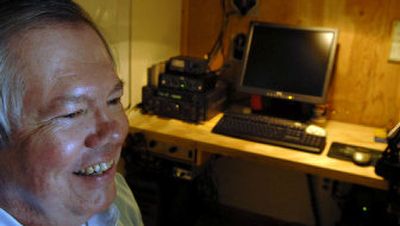Manning the airwaves

In an age of computers and mobile phones, it’s easy to forget about homegrown ways to reach out to people around the country and the world, but a dedicated group of ham operators continues to man the public airwaves seeking each other out.
Local hams will show how they do it this weekend as part of the national annual Amateur Radio Field Day. The hope is to attract new devotees to the hobby.
“We have a problem getting young people and minorities and females interested in ham radio,” said Ed Stuckey, previous president of the Kootenai Amateur Radio Society. “There are a lot of other hobbies, and kids are doing different kinds of things with the Internet.”
Stuckey, himself, got hooked as a kid on ham radios at a 1955 field day event.
Two years later he had a license and was contacting other hams across the country.
Stuckey now operates a home radio station out of a bedroom closet. His passion is contacting people with Morse code rather than talking over the radio.
During this weekend’s field day, experienced hams will help the curious make contact with operators at another United States field station. But don’t expect to spend a lot of time chatting with the radio operator in Topeka.
The event is competitive, with each field station attempting to reach as many other locations as possible. They exchange only the briefest of identifying information before attempting to locate another station.
It’s a natural extension of the way many ham radio operators like to challenge themselves. Some try to contact hams in every county in a state or states, or they work to become part of the “DX Century Club” by contacting people in 100 different countries.
The national field day is also a test to see how well ham radio operators could function under emergency conditions. If disaster were to strike, could hams hook up to generators and keep communications going?
“If the Internet goes down, we don’t,” Stuckey said. “Could we be out of the closet and without Avista supplying the power? Can we be out in the sticks somewhere?”
About 26,000 licensed hams operate in Washington, with another 5,000 in Idaho. Nationwide there are close to 650,000 licensed ham radio operators.
Buying a radio is easy, but according to Federal Communications Commission rules, operators must pass a test before they can legally transmit over the public airways.
Getting equipped with a low-powered, hand-held radio might cost $100, but hard-core hams will spend thousands to continuously improve their equipment and extend their transmission range.
Spokane DX Association President Gary Elliott said that ham radio is often confused with CB radio, but the two could not be more different.
CB radio operators are limited to the bands they can broadcast on and have more limitations than ham radio operators.
While Elliott likes Morse code, he appreciates the fact that ham radio operators can speak to people all over the world and even on the International Space Station.
“It’s the camaraderie, and the different avenues one can get into that make it interesting,” he said.